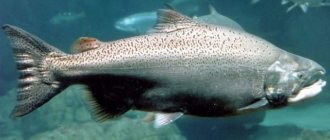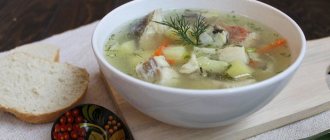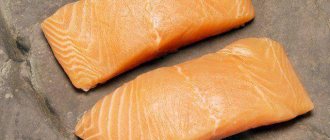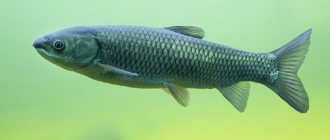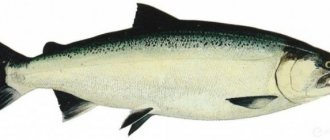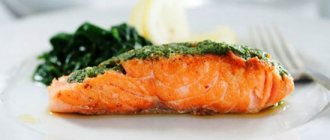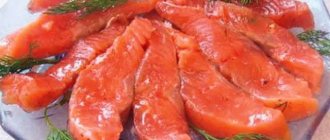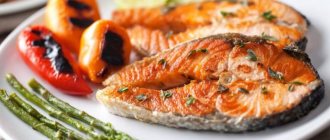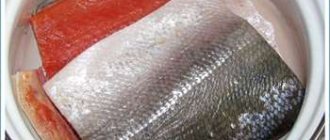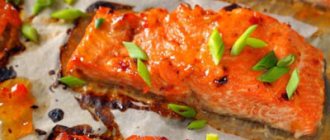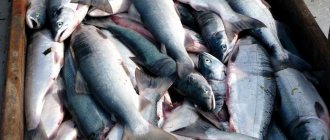Sockeye salmon is a prominent representative of the salmon family. Massive fish populations are observed in the Pacific Ocean basin. As an anadromous species of salmon, sockeye salmon are born and grow up in clean lake or river water, after which they travel to the salty waters of the Pacific Ocean in search of food.
Some types of lake forms of sockeye salmon: redfish, kokanee, dwarf never leave their native reservoirs; they do not go to the sea to feed and reproduce in their native reservoirs.
The cold-loving fish lives in waters where the temperature does not exceed 2 degrees.
The lifespan of sockeye salmon depends on the time when it goes to spawn; this happens at 4-6 years of life; having fulfilled its natural duty, it dies.
Until 2008, sockeye salmon had a protected status; thanks to the measures taken, its population recovered and the fishing ban was lifted.
The annual global catch of sockeye salmon is more than 150 thousand tons.
The size and shape of the body are very similar to chum salmon; its distinctive feature is its bright silver scales and small dark spots on the back. During the mating season, the color of sockeye salmon becomes bright red, but the head remains a pale green hue, the back and anal fins acquire a bloody tint.
Characteristics of sockeye salmon:
- The body has an elongated, flattened shape on the sides.
- The scales are round in shape and fit tightly to the body.
- The body is covered with numerous gill rakers.
- The paired fins are well developed.
Sockeye salmon is very voracious; it is a predator by nature, but it feeds not only on fry and small fish, but also on crustaceans, zooplankton, and insect larvae. Due to the large consumption of fatty red crustaceans, the pigmentation passed into the meat of the sockeye salmon. During its life, sockeye salmon accumulates carotene in its body, a yellow-orange pigment, thanks to which it acquires a bright hue.
When sockeye salmon enters fresh waters to spawn, color changes occur in the fish’s body - the silver color changes to red, and the head turns green.
Sockeye salmon spawning
Sockeye salmon have very pronounced homing - a unique phenomenon, the process of returning to a certain period of life after migration to the spawning area where it was born.
Sexual maturity occurs at 5-6 years of age. The time for sockeye salmon to spawn begins in April and lasts until November. A massive accumulation of fish along the shore in anticipation of a favorable time to enter the river mouth is observed in June. This standing can last for several weeks and, after waiting for the tide, a school of sockeye salmon rushes into the river. From the moment it enters fresh waters to spawn, sockeye salmon quickly changes color, the shape of its jaw changes, and the fish stops feeding.
To spawn, it overcomes a long, difficult journey from the ocean to a lake or river, swimming vast distances, sockeye salmon retains a supply of vitality for fruitful spawning. It is a very strong and hardy fish; on the way to the spawning ground, it will have to cope with many rapids with a multi-meter slope and long sections with riffles and fast currents.
Having found the place where the sockeye salmon hatched, it does not rush to spawn, but circulates along the shore for some time.
Features of the sockeye salmon spawning period:
- Spawning time begins at the end of July and lasts until October; in the Kuril Islands area it can extend until February.
- Over the course of 15-30 days, the female digs several holes at the bottom of the reservoir, sometimes the male helps her in this, where she lays eggs, the depth of the laying can reach 45 centimeters, it depends on the nature of the soil and the speed of the flow, this is done for the safety and preservation of the eggs.
- The female lays eggs at the bottom of the reservoir, where there is practically no current, the number of eggs in the litter ranges from 2 to 6 thousand, about 5% of unlaid eggs remains in the ovaries of the fish.
- The male irrigates the eggs with milk and the pair buries the nest.
- For several days, the female protects her offspring, clinging to stones with her teeth; she tries to die near the place where spawning took place.
- The male tries to guard the nest until the very end, drives away the loaches who like to feast on caviar, scares the swans who are trying to dig out the spawning area, and in the end he dies right there.
- In conditions of mass spawning, several changes of producers occur, as a result, the soil with laid eggs is broken several times, which leads to mass death of eggs.
- When the fry emerge from the eggs, the remains of their parents will become their first food.
Features of spawning
In Russia, salmon spawning time lasts from June to August. Fish in large schools enter the mouths of large rivers and rise up hundreds, and sometimes thousands of kilometers, to reach exactly the places where they were born. Thanks to its powerful body, Chinook salmon are able to overcome the resistance of fast currents (up to 1.5 m/s) and jump over high obstacles. Having reached the spawning ground, the females, with strong blows of their tail, form wide depressions in the pebbles and cobblestones, into which 10-14 thousand large eggs are thrown. After fertilization of the clutch by males, the life cycle of the spawners ends and their bodies begin to quickly deteriorate.
To learn more:
Description of the trout fish - how is it useful?
Nature has provided an additional mechanism of biological regulation, which allows the same shallow-water spawning grounds to be used without excessive pressure of fish. Many river systems host several spawning migrations of Chinook salmon per season, spaced one and a half to two months apart. This period of time is enough for the water to be cleared of rotting organic matter, and for the eggs to develop into a nimble and tenacious pied fry that can quickly find reliable shelters. This regulatory scheme is especially clear on the coast of North America. Here spring and autumn species forms have developed, which spawn in the same rivers in different seasons.
Sockeye salmon habitats
Schools of sockeye salmon live in the Sea of Okhotsk and the Bering Sea, in the area of the Commander Islands, on the eastern coast of Kamchatka, off the coast of Alaska and Canada. Sockeye salmon is distributed in the area from Chukotka to Anadyr. To spawn, it goes into the basin of the Anadyr River, the rivers of Kamchatka, the Kuril and Commander Islands.
Lake forms are artificially grown in Japan and Great Britain.
Sockeye salmon live in sea waters for about 4 years, then they reach sexual maturity, and the fish returns to the lake or river to spawn.
Grown-up fry begin their journey to the ocean; this cyclical process is repeated for thousands of years.
Sockeye Salmon Lifestyle
Sockeye salmon is a migratory species that forms a lacustrine habitat, so its lifestyle takes place in both fresh and cold salt water.
The first two or three years of life, fresh water bodies are its native habitat, here it hatched from eggs, and here it, having spawned eggs, will finish its life cycle.
In sea waters, sockeye salmon grow to sexual maturity, gain weight, and at the age of 4-6 years return to their native clean fresh river or lake waters.
During the spawning period, sockeye salmon in schools, overcoming rapids and shallows with sharp stones, returns to the places where they were born to spawn and complete their life cycle. Along the route, the fish is exposed to danger from birds of prey and bears who love to feast on the tender, fatty meat of red fish.
The lifestyle of sockeye salmon is as follows:
- At the spawning grounds, individuals break up into pairs and begin to prepare a place for the nest.
- Larvae appear from the bottom eggs, 4-5 mm in diameter, 150-170 days after fertilization at a water temperature of at least 2 degrees. Mortality during the maturation period is about 30%.
- The mass emergence of fry from the ground occurs in May and June. The fry, about 3 centimeters long, roll into the main river bed or into the open part of the lake.
- Juvenile sockeye salmon live in fresh waters for 3 years, during which time up to 90% of the fry that emerge from the eggs die. Having grown stronger, they gather in small flocks and go out to the open sea to gain weight.
- Sockeye salmon lives in the sea for no more than 3 years, then returns again to its spawning site, where it came from.
- The spawned fish dies, the larvae appear only after 5-7 months, this depends on external conditions and the location of the eggs.
Nature has embedded in the sockeye salmon’s DNA a program of reproductive instinct: to give birth to offspring and die in the same place where it emerged from the egg. After the mass death of spawning fish, due to the remains, the productivity of the reservoir significantly increases, which is a good food supply for the fry.
Sockeye salmon has a pronounced predatory behavior, it is omnivorous and very voracious, its constant diet consists of crustaceans, mollusks, squid, insects, and small fish.
On the way to the spawning ground, sockeye salmon have many natural enemies: large and small predatory animals and birds, and even crayfish that wait near the stones for exhausted fish. Poaching and environmental pollution cause considerable damage to the population.
What is Chinook salmon?
Due to its outstanding size, chinook salmon (in the Itelmen dialect - “ch'uch'u”) are often called princely or king salmon, which is reflected in the official American name of the taxon - King Salmon. Excellent gastronomic qualities and active resistance when fishing have made it a popular object of commercial, sports and recreational fishing. This fish of the salmon family leads an anadromous (anadromous) lifestyle with pronounced river and oceanic phases.
The only spawning, development of eggs, emergence of fry (parts) and growth of juveniles (from 3-4 months to 1-2 years) occur in fresh water. Full maturation, formation of reproductive function and feeding of the main mass is carried out already in the marine environment. But there are exceptions - some males do not leave the river, forming a residential dwarf subspecies that acquires the ability to reproduce at 2-3 years with a small size of 12-45 cm.
The life expectancy of Chinook salmon is quite short, only 4-8 years. This is due to fatal hormonal changes in the body during the pre-spawning period. Over the course of 1-2 weeks, all producers who took part in the spawning process completely die.
Where does it live?
The original territories of residence of king salmon in Russia are the Arctic Ocean basin, the Barents and Okhotsk Seas, the Commander Islands, Amur, Anadyr, Chukotka, and the Kamchatka Peninsula. In the USA, Canada and Japan, the species lives in the Sacramento and Coppermine basins, near northern Hokkaido, the Aleutian Islands, Alaska, Cape Krusenstern, and the Kent Peninsula. Freshwater bodies in this area are characterized by low temperatures, sparse vegetation, and poor plankton and benthos. The shortage of food supply was the main reason that forced the fish to go out to feed in the sea.
To learn more:
Salmon is a red fish from the salmon family.
She has developed a special hypo-osmotic mechanism that allows her to easily adapt to life in water of any salinity. Chinook salmon thrive both in desalinated estuaries and bays, and in the open Pacific Ocean several thousand kilometers from the coast. At the same time, the reproductive function remained unchanged - the development of eggs occurs exclusively in the conditions of flowing cool rivers with a pebble or rocky bottom.
In order not to create food competition for growing juveniles and future offspring, during the pre-spawning period the salmon's gastrointestinal tract irreversibly atrophies, the place of which is taken by an additional volume of eggs and milt.
Methods of catching sockeye salmon
Sockeye salmon is a particularly valuable commercial fish species; industrial fishing allows fishing with floating nets and cast seines.
Sockeye salmon is also of interest to anglers. Although in fresh water it stops feeding, it still grabs the bait, this is partly explained by the preserved feeding reflex and aggressive behavior associated with protecting the spawning area.
Fish responds well to spinning, whip baits or float tackle using natural bait; spinners can be rotating or vibrating.
When choosing a spinning rod for catching sockeye salmon, it is necessary to take into account the conditions of the reservoir; it is recommended to use a spinning reel with a fishing line with a diameter of at least 0.3 mm; it is advisable to have at least 100 meters of fishing line on the reel.
The main requirement for gear is its reliability, since sockeye salmon are active and when caught on bait, they strongly resist.
Which is better sockeye salmon or coho salmon
Sockeye salmon and coho salmon are very similar in appearance, but with the same length, the weight of a coho salmon carcass is twice that of a sockeye salmon carcass. Unlike chum and coho salmon, sockeye salmon does not have a silvery coating on the caudal fin. A large number of gill rakers is also one of the distinctive features.
Let's take a closer look at what is better: sockeye salmon or coho salmon?
- The flesh of coho salmon is much paler than that of sockeye salmon.
- The calorie content in both fish is approximately the same, the fat composition is 40-48%.
- Sockeye salmon caviar has a bitter taste, while coho salmon does not have any specific taste.
- Small eggs are almost the same size, about 4 mm in diameter.
- The cost of coho salmon is three times higher than the cost of sockeye salmon.
Nutritionists admit that sockeye and coho salmon are not inferior to each other in their beneficial qualities, although the caviar of the latter contains a higher content of valuable biological substances. Coho salmon meat is considered the most delicious and refined; it is used in gourmet culinary dishes.
Nutritional value of sockeye salmon
The pulp has a high taste and contains many elements beneficial to humans, which is why it is a dietary product.
Commercial fish has an original external color, soft flesh structure and excellent taste characteristics. Sockeye salmon meat is very fatty, does not contain carbohydrates, 100 grams of pulp contains 131 kcal, this is the daily requirement of protein and fat. Sockeye salmon contains fat-soluble and water-soluble vitamins in large quantities: A, D3, E, K, the entire group of B vitamins, phosphorus, potassium, selenium, sodium.
The nutritional value of sockeye salmon lies in the fact that it has a rich vitamin and mineral composition, which is necessary for the full functioning of the human body, neutralizing toxic substances and restoring the functioning of the digestive system. Red meat is an excellent natural antioxidant that normalizes metabolic processes in the body.
Boiled sockeye salmon meat is recommended for children over one year of age; it is easily digestible and helps strengthen the immune system. The red pulp contains a large amount of phosphorus, which contributes to the preservation of bone tissue in older people.
Sockeye salmon can be prepared in various ways: salted, smoked, stewed and baked in the oven or grill; the salted pulp is used to prepare appetizers and salads. Sockeye salmon soup has an excellent rich taste; the dish is cooked from a whole carcass with head and tail. Fish caviar is used in preparing Oriental and European dishes.
Migratory fish - their beneficial properties and how to properly cook fish
Migratory fish are those that live in the seas, but enter rivers to spawn (salmon, sturgeon, except sterlet, and some others) or, conversely, live in fresh water, but enter the seas to spawn (eel).
Salmon family
The word salmon does not correspond to any fish species in the family of the same name. This is the collective name of a subfamily and family of the same name (just like trout is the name of a large group of fish species united by common properties). Let's look at it in detail: the term “salmon” is present in the names of more than a dozen different species of fish belonging to different subfamilies, as well as in the names of two genera:
Class - Ray-finned fish
- Order - Salmonidae
- Family - Salmonidae
- Subfamily - Salmon (lat. Salmoninae)
- Genus - Noble salmon (lat. Salmo)
- Species – Noble Salmon (or Salmon)
- Species - Taimen (or Trout)
- Species – Brook trout
- and so on
Salmon are one of the most valuable commercial fish. Salmon meat is very tender, fatty, excellent taste and has almost no muscle bones. High-quality gastronomic products are made from fish of this family: lightly salted and smoked fish, balyk products, canned food (mostly natural), caviar. In cooking they are used to prepare cold appetizers and a variety of first and second courses. An important characteristic of most salmon is their ability to ripen when salted.
Chinook
“King Salmon” or “Prince of Salmons”, this is how Chinook salmon is called not only for its relatively large size and weight, but also for the benefits to the body when eating Chinook salmon meat or caviar. The “King Salmon” lives primarily off the American Pacific coast. In Russia, Chinook salmon fishing is carried out in Kamchatka (in the Anadyr and Amur rivers). The average length of the fish is 80 - 90 cm, but larger specimens are also found. The weight of the fish is from 30-40 kg. up to 60 kg.
A distinctive feature of Chinook salmon is that there are small black spots on the back, dorsal and caudal fins. Eating Chinook salmon meat is extremely beneficial, especially during periods of great mental stress (for example, schoolchildren and students during exam periods) or physical fatigue. Unique acids - docosahexaenoic and ecosapentaenoic - support brain activity and strengthen the cardiovascular system.
Chinook salmon caviar is useful for strengthening bone tissue and in recovery from fractures. Chinook salmon has a beneficial effect on the human body in the prevention of atherosclerosis, arrhythmia and (attention) depression. Due to the high fat content in Chinook salmon meat, it should be consumed with caution by people with gastrointestinal diseases and chronic diseases such as enteritis, pancreatitis, cholecystitis. The calorie content of 100 grams reaches 148 kilocalories.
The color of salted (lightly salted) chinook salmon is more saturated and this distinguishes it from the same lightly salted salmon, but according to gourmets, lightly salted chinook salmon is preferable.
Chinook salmon is good for making salads, appetizers or for frying, but it is unlikely to make dietary fish soup from it.
Chum salmon
It lives in the north Pacific Ocean, off the coast of North America, in the Okhotsk and Bering Seas. Valuable fishery object. The maximum recorded body length is 100 cm, weight is 15.9 kg, with an average of 60 cm and 3 kg, respectively.
Fish is rich in omega-3 and omega-6 polyacids, as well as lecithin, so it can be considered an excellent anti-atherosclerotic agent. With its frequent use, you can significantly reduce the risk of a heart attack. Chum salmon contains large quantities of potassium and magnesium - minerals that are important for the normal functioning of the heart muscle.
It also contains calcium and phosphorus, which restore and strengthen bone tissue. Chum salmon has appetizing, tender, dietary meat, as well as delicious red caviar. It should not be fried like other fish, as this makes the meat dry.
Chum salmon fillet is great for baking in the oven with vegetables and spices to taste, for frying in batter and for soups.
Char
The genus of loaches is very diverse and widespread from the Arctic Circle to the Alpine lakes and the Baikal basin, as well as to the Amur River basin and California along the Asian and American shores of the Pacific basin. The central species of the genus is Arctic char. A predator reaching 80-90 cm, but the fish on the shelves, as a rule, are small in size - 30-35 cm, which is very convenient for use (quite a portion). Another “plus” of char is that it has no scales, which means it has a tasty and crispy skin after baking or frying.
Char is a fish that is not dry, but also not greasy, like some other salmon (that is, do not overcook it in the oven, so as not to dry it out). The meat of this fish is rich in omega-3 acids, vitamins E, B6 and B12, which inhibit the aging process, as well as calcium, magnesium, iron and the “calm vitamin” - niacin - necessary for the release of energy from food. The beneficial properties of fish, as well as its attractive appearance, are preserved even after cooking, in salted and even smoked form.
It is customary to fry or bake char in the oven (preferably with lemon oil), and use it to make fish soup and as a filling for pies. Lightly salted char is an undeniable delicacy.
Wash the gutted carcass without head and fins and dry with a paper towel. Then, rub (both outside and inside) with salt and ground white pepper, cover with butter mixed with lemon zest and place in the oven for about twenty minutes. Then, without foil, under the grill for about five minutes.
Salmon
Noble or Atlantic salmon - belongs to the genus Noble salmon. It lives in the northern part of the Atlantic Ocean, in the basins of the Barents, White and Kara seas. The meat is tender, pink in color, contains 11% fat in summer, and from 16-17 to 24% in autumn. The average weight is from 4 to 10 kg, length 70 - 80 cm, but can reach 40 kg, 1.5 m, respectively. Salmon is one of the most beautiful species of salmon.
